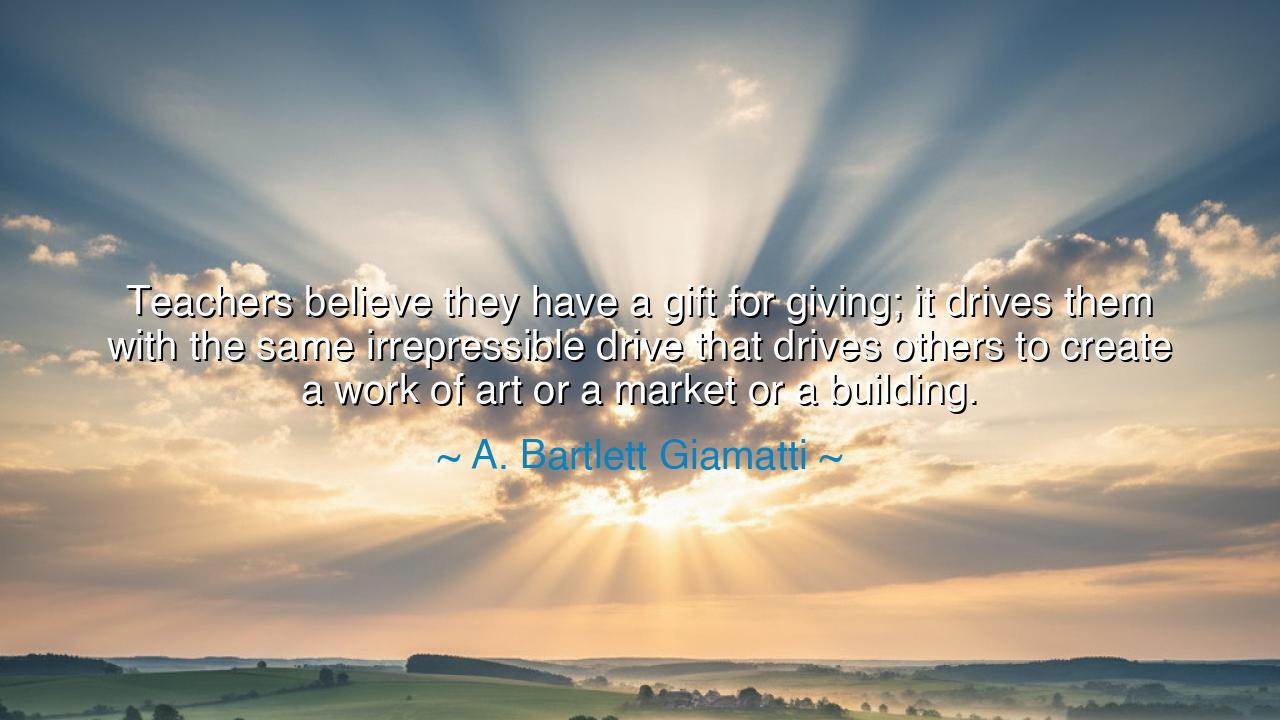
Teachers believe they have a gift for giving; it drives them
Teachers believe they have a gift for giving; it drives them with the same irrepressible drive that drives others to create a work of art or a market or a building.






Hear the stirring words of A. Bartlett Giamatti: “Teachers believe they have a gift for giving; it drives them with the same irrepressible drive that drives others to create a work of art or a market or a building.” In these words, he reveals the sacred calling of those who instruct the young. For just as the painter is consumed by vision, the merchant by enterprise, the architect by design, so too the teacher is seized by the fire of generosity. Theirs is not the gift of possession, but of surrender — the act of pouring themselves into the lives of others, shaping minds and spirits, not for personal glory, but for the flourishing of generations.
The ancients knew this truth well. Socrates did not wield a sword nor sculpt in marble, yet his gift for giving ideas to the youth of Athens changed the course of philosophy forever. Confucius, traveling from province to province, gave not wealth nor armies, but wisdom, ordering the souls of nations for millennia to come. These were not men who built markets or temples of stone — they built temples of thought, markets of virtue, and monuments of wisdom within the hearts of those who listened. Their drive was irrepressible because it was not born of selfish desire, but of the compulsion to bestow what had been entrusted to them.
The comparison to art, market, and building is not mere ornament. The artist feels compelled to paint, not for praise alone, but because creation itself burns within. The merchant builds his trade because he envisions growth, exchange, and the fruit of human need fulfilled. The builder cannot rest until his design rises in stone against the sky. Likewise, the teacher cannot silence the urge to guide, to awaken, to shape. To withhold is impossible; to give is inevitable. Their classroom, no matter how humble, becomes their canvas, their workshop, their cathedral.
Consider the life of Anne Sullivan, whose drive to give transformed the life of Helen Keller. Blind herself and burdened with hardship, Sullivan did not hoard her knowledge or allow her pain to silence her calling. Instead, she poured forth her gift for giving, teaching Keller to communicate with the world. Through her, Keller became not only educated, but a beacon of hope for millions. Sullivan’s teaching was no different from Michelangelo painting the Sistine Chapel — it was artistry of the soul, driven by the same irrepressible necessity to create beauty, though hers was not in stone or paint, but in the awakening of a human spirit.
Yet the gift of the teacher is not without sacrifice. Unlike the artist whose signature endures on canvas, or the builder whose towers rise in the skyline, the teacher often labors unseen, their influence hidden in the lives of others. Their art is carried silently in the words, deeds, and choices of their students. But make no mistake: this hiddenness does not diminish the greatness of their work. For is not the seed, buried and unseen, the very beginning of the forest? Is not the foundation, invisible beneath the earth, the strength of the building above?
What lesson, then, do we draw from Giamatti’s words? It is this: honor the teacher, for their labor is no less noble than the sculptor, the merchant, or the architect. See them not as mere functionaries of a system, but as creators, builders of souls, visionaries who design the unseen architecture of society. And if you yourself are called to teach — in classrooms, in homes, in daily life — embrace it as the sacred artistry it is. Let the fire of your gift for giving burn without shame or hesitation.
Practically, let us support those who teach. Encourage them, thank them, provide them the tools they need, just as we would provide brushes to an artist or stone to a builder. And for each of us, whether formally teachers or not, let us remember that every act of sharing wisdom, every word of encouragement, every moment of patience with the young, is an act of creation. We too are builders, artists, givers of light.
So let the echo of Giamatti’s words guide us: “Teachers believe they have a gift for giving.” Treasure that gift, and learn to embody it in your own life. For though paintings may fade, markets may fall, and buildings may crumble, the gift of teaching — given in love — endures beyond time, living on in the souls it awakens.






AAdministratorAdministrator
Welcome, honored guests. Please leave a comment, we will respond soon